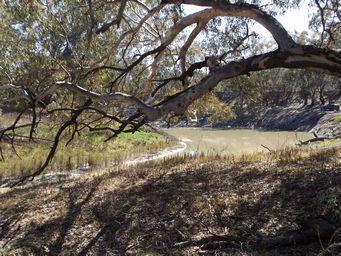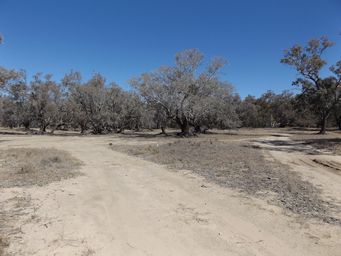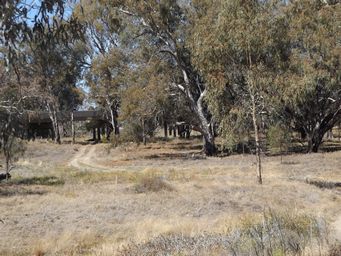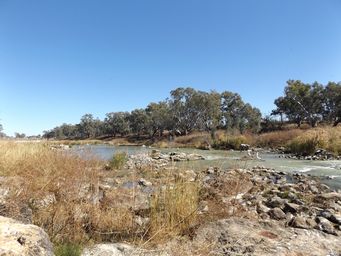The weir has slowed the flow of the river, and there are now lots of little islands, where in the past there was only one large island.
There is also a build-up of silt that is now entering the fish traps. The fish traps have endured significant damage as a result of
the weir, and have suffered from the loss of traditional management and maintenance.
Australia So Much to See
New South Wales - Walgett and on to Brewarrina to see the oldest man made structure on Earth




The floodplain between the river and the highway provided plenty of parking (above), and evidence of it being used for camping. There were people camping along the river (above right).
Tracks continue under Dangar Bridge (at right).
The doldrums of drought at Walgett have been replaced by farms in full production, and the support crews associated
with a busy harvest have kicked into gear.
After years of no cropping income, farmers in the Walgett Shire are frantically harvesting
a bumper crop of wheat, barley and chickpeas.
While around Coonamble it appeared that farmers were having poor seasons, nearing Walgett the stubble from the previous year’s crops
looked like they’d had a good year. A newspaper article from December 2016 explains
Walgett is just one of a number of northern New South Wales inland towns that had a reputation of being unsafe for tourists. Boarded up shops, bars on the windows and deserted streets creates an image often associated with remote communities with high
rates of crime and disadvantage.
But that is changing as local business owners embrace new measures to make the main street more
inviting and revamp the town's image, according to this August 2017 news report, which coincided with our visit to Walgett.
On a sunny winter morning in Walgett at an outdoor cafe on the main street, paramedics, farmers and tourists are having a chat, a coffee and a bite to eat.
It does not look like a place with a bad reputation, but Katie Hook from Café 64 remembers when the
town was mocked by comedian Kevin 'Bloody' Wilson.
"He said Walgett was the only town with a minimum security jail and a maximum
security main street,"
Ms Hook said while it was intended as a joke, it was true at the time. "Every single shop in the
Main Street had bars, roller shutters that locked, bullnose verandahs so if the shop wasn't open it was a fortress," she said.
Café
64 is now among a growing number of shopfronts in Walgett without bars on the windows.
While many businesses in the is small
town have been unable to afford to renovate their premises, the council is offering subsidies to help business owners beautify their
shopfronts and Walgett Shire Manager Don Ramsland said it was delivering results. Walgett certainly appeared similar to
other rural towns in 2017.
The road from Walgett to Brewarrina followed the Barwon River floodplain, with little sign of cropping at first; just grazing land. Nearer Brewarrina there were tell-tale tufts of cotton along the road, then irrigated cotton farms, mostly on the southern side of
the river. Approaching Brewarrina, we crossed the Barwon on a bridge close by the historic lift bridge.
Brewarrina was
once the furthest navigable point paddle-steamers could reach on the Darling River system. Commercial paddle steamers worked the river
freight route from 1859 to 1931. The historic Brewarrina Barwon Bridge was built in 1889 to allow paddle-steamers to pass below.
This bridge and the lift bridge at North Bourke are the only two remaining examples of the early lift bridges in New South Wales.
The name Brewarrina is derived from 'burru waranha', a local Aboriginal name for a species of Acacia.
Brewarrina's most significant feature is its Aboriginal fish traps. Known in the local Aboriginal language as Baiame's Ngunnhu, it
is believed that Ngemba, Wonkamurra, Wailwan and Gomolaroi people have shared and maintained the traps for thousands of years. Locals
claim that the traps are at least 40,000 years old and are the oldest known man-made structure in the world.
The first European settlers arrived in Brewarrina in the early 1840s, and by 1860s the town was a river port for the transportation
of local wool and supplies. Brewarrina was once a base for the Cobb & Co stagecoach company.
In 1901 the Brewarrina
railway line opened to Brewarrina from Byrock, on the Nyngan to Bourke line. The Brewarrina Line closed in 1974 and the wood-framed
Brewarrina Station was lost to fire in 1980.
Walgett takes its name from an Aboriginal word meaning 'the meeting place of two rivers'. Walgett lies on the Namoi River, which
skirts the east and north-east of the town from where it eventually joins with the Barwon River some five kilometres north-west of
the town.
The name "Barwon" is derived from the Aboriginal words of barwum, bawon or baawan, meaning great, wide, awful river
of muddy water. Regular steamer services ran from Walgett to Bourke during 1880 to 1912. During the floods of 1879 and 1886
the steamers were able to travel into Collarenebri and even as far as Mungindi in 1890.
The word Namoi or nammoy is thought to
be the Aboriginal name for a species of acacia.
A post office was gazetted for "Wallgett on the Barwin River" in 1851
and the town sites were surveyed in 1859. The district would have been occupied prior to this by squatters with their livestock. The
town of Walgett was proclaimed on 20 March 1885.
The small town of Walgett is the rural service centre for an enormous pastoral
area which stretches to the Queensland state border.
The town describes itself the 'Gateway to the Opal Fields' as it is on
the road to Lightning Ridge and the Grawin, Glengarry and Sheepyard Opal Fields. The district around the town is known for its wool,
beef cattle, chick peas, barley, lucerne, fat lambs, sheep studs, cotton and wheat.
While Lightning Ridge is very much a tourist
town, and within the Walgett Shire, Walgett has never been a favoured tourist destination.
In 1901 Australian surveyor and self-taught anthropologist Robert Mathews wrote this description of the process: 'During the early spring months of the year, or at any time when there was a fresh in the river, the fish travelled upstream in immense numbers. The stone pens or traps had their open ends towards the direction from which the fish approached ... as soon as a sufficient number of the finny tribe had entered the labyrinth of traps, the openings were closed by means of large stones which had been placed alongside ready for use ... The natives next entered the pens and splashed the water with their hands or feet, thus frightening the fish into the smaller enclosures, where they were more easily caught.' Ref: Aussie Towns



